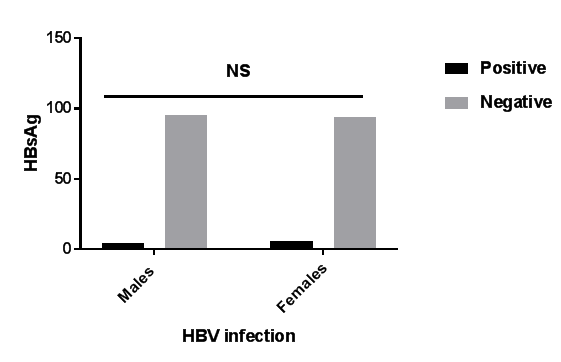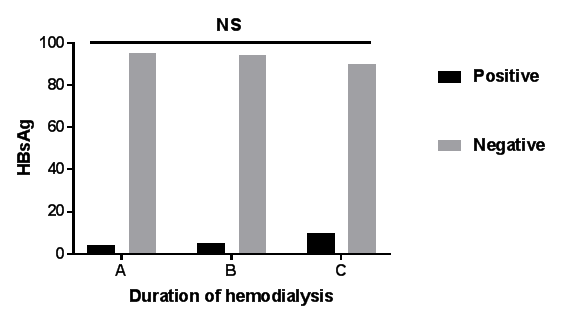MOJ
eISSN: 2574-9722


Research Article Volume 3 Issue 4
1Department of Microbiology, Faculty of Medical Laboratory Sciences, University of El Imam El Mahdi, Sudan
2Department of Cytology and Histopathology, Faculty of Medical Laboratory Sciences, University of El Imam El Mahdi, Sudan
3Department of Microecology, College of Basic Medical Sciences, Dalian Medical University, China
Correspondence: Babiker Saad Almugadam, Department of Microbiology, Faculty of Medical Laboratory Sciences, University of El Imam El Mahdi, Kosti city, Sudan, Tel 00249917717034
Received: August 15, 2018 | Published: October 23, 2018
Citation: Ali RN, Allah TR, Osman TE, et al. Serological detection of hepatitis B virus infection in patients under hemodialysis. MOJ Biol Med. 2018;3(4):186–188. DOI: 10.15406/mojbm.2018.03.00096
Hemodialysis (HD) predisposes patients to blood born viruses infections include hepatitis B virus. This work was planned to estimate the rate of Hepatitis B virus infection among hemodialysis patients through the serological detection of HBsAg seropositivity. During the period from August to November 2017, a total of 100 blood samples (68 males, and 32 females) were collected. Each sample was serologically tested for HBsAg using immunochromatographic tests according to manufactures instructions. Out of the total of participants, the overall frequency of Hepatitis B virus infection was 5%. In addition, the occurrence of Hepatitis B virus infection in males (4.4%) and females (6.3%) or among the duration of hemodialysis revealed non-significant difference. Moreover, HBsAg seropositivity was positively correlated with the duration of hemodialyis. Our findings conclude hemodialysis is a risk factor for hepatitis, therefore, the isolation of separated machine and area for HBV positive patients together with immunization of patients undergoing dialysis must be implemented. Furthermore, health education must conduct among those patients to generate the health awareness.
Keywords: hemodialysis, HBV, HBsAg, infection, Sudan
HBV, Hepatitis B virus; HD, Hemodialysis
Hepatitis B virus (HBV) is a DNA virus belongs to Hepadnaviridae family.1 It affects hepatocytes leading to a broad-spectrum liver disease that arrange from acute or chronic hepatitis B, to cirrhosis and hepatocellular carcinoma.2 HBV infection occurs as a result of transmission of virus through body fluids or sexual contact.3 Hemodialysis (HD) predisposes patients to blood born viruses especially HBV as a result of blood recycling in this process.3 HBV infection is a major health challenge worldwide and there are 2billion people with serological markers of Hepatitis B virus infection globally; and 257million of these cases are chronically infected.4 In addition, the frequency of HBV infection among hemodialysis patients in Western Europe, United States of America and Japan was 0-6.6%.5 While, nevertheless, the development of advance and rapid diagnostic tests, the epidemiology of this infection in Sudan is poorly understood. HBV surface antigen (HBsAg) is excellent serological marker for diagnosis of HBV infection, as it presents in both acute and chronic state.6 This study was conducted to determine the frequency of Hepatitis B virus infection among hemodialysis patients through the serological detection of HBsAg.
This cross sectional, hospital based study, conducted in Kosti Renal Dialysis center during the period from August to November 2017. Kosti Renal Dialysis center is located in Kosti city of White Nile state, it provides health service for the population of Kosti city and it is surrounding areas. The study approval was provided by University of El Imam El Mahdi and all the steps were performed in according to declaration of Helsinki and ethical standards of human research. In addition, verbal informed consent was taken from each participant before sample collection.
Study population and sample size
Our study participants include those attended to Kosti Renal Dialysis center regardless of age, gender or duration of hemodialysis. Throughout the study duration, a total of 100 participants were incorporated. The distribution of participants among males and females were 68 and 32, respectively. Moreover, the 100 participants were divided into 3 group’s base on the duration of hemodialysis, Table 1.
Group |
Duration of hemodialysis per year |
Number of patients |
A |
From day–up to 4years |
71 |
B |
More than 4–up to8years |
19 |
C |
More than 8–up to12years |
10 |
Total |
100 |
|
Table 1 Distribution of participants among the duration of hemodialysis
Laboratory diagnosis
Blood samples were collected from each participant, left at room temperature for 15minutes then centrifuged at 3000rpm for 10minutes to obtain serum.7 All serum samples were tested serologically for HBsAg using immunochromatographic tests (Humasis kits) according to manufactures guidelines.
Statistical analysis
Graph Pad Prism version 7.05 software was included to analyze the data. The statistical difference of HBsAg seropositivity between gender and among the duration of hemodialysis was tested by Chi square test. P value of ≤0.05 was considered significant. Furthermore, the association of HBV infection with the duration of hemodialysis was assessed by Pearson correlation coefficient.
Out the total of study population, the frequency of Hepatitis B virus infection was 5% (Figure 1). In addition, there is non-significant difference in the occurrence of Hepatitis B virus infection between males (4.4%) and females (6.3%) or among the duration of hemodialysis, Figure 2 and 3 respectively. Furthermore, the seropositivity of HBsAg was positively correlated with the duration of hemodialysis (Figure 4).

Figure 2 Distribution of Hepatitis B virus infection in males and females. HBsAg seropositivity revealed no significant difference (NS), P value =0.654.

Figure 3 Hepatitis B virus infection among the duration of hemodialysis. However, out of the total of participants in every duration, the frequency of HBsAg seropositivity was 4.2%, 5.3%, and 10% in A, B, and C group, respectively, there is no statistical difference in seropositivity, P value=0.775.
Hepatitis B virus infection is a major health threatening worldwide especially among hemodialysis patients and it can associate with a serious complications. Ours work was reported, out of 100 participants, 5% has serologic marker of HBV infection. This finding disagree with Zahedi MJ et al.,8(Iran, 2012), Luma HN et al.,9 (Cameroon, 2017), Yadegarynia D et al.10 ( Tehran, 2017), Mohammed AA et al.,11 (Khartoum state-Sudan, 2015) and Abumwais J and Idris OF (Jenin, 2010)12 study which reported the frequency of HBV infection among hemodialysis patients were 7%, 10.6%, 1.39%, 9%, and 0%, respectively.8–12 While, it similar to Bahri F et al.13 study that reported the rate of hepatitis B virus infection (HBsAg) was 5.88%.13 The slight difference in the frequency of HBV infection among hemodialysis patients in our study area compare with other countries or area within Sudan may exist from the use of small sample size in this study.
Furthermore, the distribution of HBsAg seropositivity in males (4.4%) and females (6.3%) revealed non-significant difference, p value more than 0.05. Different findings were stated by Luma HN et al.9 and Mohammed AA et al.11 study which reported the frequency of HBV infection among males was 8.82%, and 10.77%, respectively ; and among females was 13.88%, and 5.7%, respectively.9,11 While similar results was reported by Bahri F et al.13 study that found the frequency of HBsAg was 6.4% in males and 5% in females.13 Despite the higher or lower prevalence of HBV infection in this study compare with anthers, these results may reflect the gender has no significant impact in HBV infection among hemodialysis that is supported by the previous mentioned studies.
The known fact that the increase of exposure for certain hazard, may associate with high risk of getting harm. In addition, as we reported, regardless of the percentage of HBV infection is increased with the duration of hemodialysis and HBsAg seropositivity is positively correlated with the duration of hemodialysis in this work, our data did not show significant difference in the occurrence of HBV infection which may arise from the use of small sample size in this study.
Our study concluded that the rate of HBV infection among hemodialysis patients in Kosti city was slightly lower or higher compare with other countries or areas in Sudan. Moreover, our findings indicates hemodialysis is carry a risk factor for hepatitis, therefore isolation of separated machine and area for HBV positive patients together with immunization of patients undergoing dialysis must be implemented. In addition, health education must conduct among those patients to generate the heath awareness.
We would like to thanks the participant patients and staff of Kosti Renal dialysis Center for their support during samples collection.
This study has not been funded by any organizations or institution. Only authors supported this work.
We declare that we have no conflict interests.

©2018 Ali, et al. This is an open access article distributed under the terms of the, which permits unrestricted use, distribution, and build upon your work non-commercially.